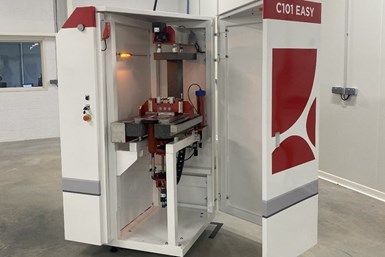3DCeram C101 Easy Ceramic Printer for Development, Prototypes
The printer is designed for ease of use, offering plug and play for ceramic 3D printing.

Photo Credit: 3DCeram
3DCeram’s C101 Easy ceramic 3D printer is designed for manufacturers looking to develop and scale up into industrial production. This smaller, lab version is well suited for development, prototyping and producing small series of small ceramic parts.
It is said the printer is easy to use, offering optimized accessibility thanks to its open design. Using stereolithography (laser) technology, all the parameters are opened for the customers to develop their materials and recipes.
It is also optimized for material consumption. Users can print with as little as 60 mL of ceramic to start a print or 10 mL with the SAM (Small Amount of Material) option. Powered by a cartridge, the machine has a build platform of 100 × 100 ×150 mm.
The company says the machine is easy to use and launch a run. The machine is equipped with a collecting support which enables the recycling of the unpolymerized ceramic. Also, the recycling cartridge is fixed on a support which is easily removed from its storage, while the support can be repositioned in its place and a production can be restarted.
The build platform has been designed to facilitate maintenance and cleaning in a few minutes so as not to lose time between 2 prints, 20 minutes when using the same ceramic material and 40 minutes if using another ceramic slurry.
- Read about the 2022 edition of Formnext which revealed more options and applications for 3D printed ceramics and more.
- Check out our Ceramic Zone to read and see all things ceramic.
Related Content
-
Foundry Lab: How Casting in a Day Will Improve the Design of Metal Parts (Includes Video)
The company’s digital casting process uses 3D printing, but the result is a cast part. By providing a casting faster than a foundry, the company says effective prototyping is now possible for cast parts, as well as bridge production.
-
Shape Lab Develops MyCera to Reinforce 3D Printed Clay Structures
Mycelium is an intelligently oriented fiber reinforcement that can increase the structural performance of 3D printed unfired clay elements and enable bio-welding of fired elements.
-
Cranial Implant 3D Printed From Hydroxyapatite Ceramic: The Cool Parts Show #76
Cranial implants are typically made from titanium or PEEK; in this episode of The Cool Parts Show, we look at how implants made from a bioceramic can improve osseointegration and healing.














